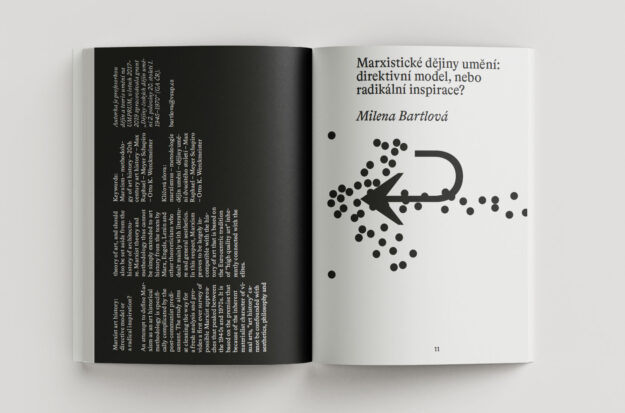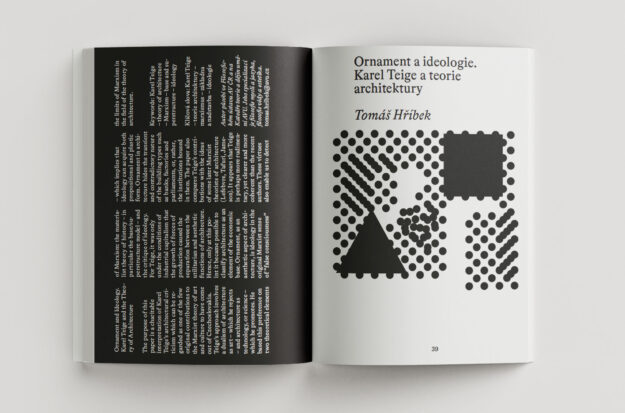The 29th issue of the Notebook for Art, Theory and Related Zones looks at the application of Marxist approaches to art and art history. The guest editor Milena Bartlová issued an open call for texts that examine the topic from a variety of different angles. Bartlová begins by summarising Marxist concepts of art history to date. Tomáš Hříbek then writes about Karel Teige and his original Marxist contribution to a theory of architecture. The third peer-reviewed essay is penned by the Polish art historian Agata Pietrasik and outlines the educational strategies of the Museum of Modern Art in Łódź, the director of which from 1935 to 1965 was Marian Minich; the text is published in the original English version. The final essay is a detailed analysis of the theory of the nude in Czechoslovak photography of the 1950s and 1960s by Marianna Placáková. The issue concludes with reviews of two books dealing with socialist realist art in Slovakia: Prerušená pieseň by Alexandra Kusá, and Súmrak doby by Bohunka Koklesová. They are reviewed by Johana Lomová and Hana Buddeus.
Content
Milena Bartlová
Marxist art history: directive model or a radical inspiration?
An attempt to define Marxism as an art historical methodology is specifically complicated by the post-communist predicament. The study aims at cleaning the way for a fresh analysis and provides a first ever survey of possible Marxist approaches that peaked between the 1940s and 1970s. It is based on the inherent materialist character of visual arts, „art history“ cannot be confounded with aesthetics, philosophy and theory of art, and should also be set aside from the history of architecture. Marxist theory and methodology thus cannot be simply extended to art history from the texts by Marxs, Engels, Lenin and other theoreticians who dealt mainly with literature and general aesthetics. In this respect, Marxism proves to be largely incompatible with the history of art that is based on the Eurocentric tradition of „high quality art“ inherently connected with the elites.
Tomáš Hříbek
Ornament and Ideology. Karel Teige and the Theory of Architecture
The purpuse of this paper is a charitable interpretation of Karel Teige´s architectural criticism which can be regarded as one of the few original contributions to the Marxist theory of art and culture to have come out of Czechoslovakia. Teige´s approach involves a dualism of architecture as art – which he rejects – and architecture as technology, or science – which he promotes. He based this preference on two theoretical elements of Marxism: the materialist theory of history – in particular the base/superstructure model – and the critique of ideology. For Teige, it was only under the conditions of industrial capitalism the the growth of forces of production caused the separation between the utilitarian and aesthetic functions of architecture. Hence, only at this point it became possible to classify architecture as an element of the economic base. Ornament, as an aesthetic aspect of architecture, is ideology in the original Marxist sense of „false consciousness“ – which implies that ideology can acquire both propositional and plastic form. Ornament in architecture hides the transient and contradictory nature of the building types such as banks, factories and parliaments, or, rather, the institutions housed in them. The paper also compares Teige´s contributions with the ideas of some later Marxist theorists of architecture (Lefebvre, Tafuri, Jameson). It appears that Teige is perhaps more rudimentary, yet clearer and more coherent than the recent authors. These virtues also enable us to detect the limits of Marxism in the field of the theory of architecture.
Agata Pietrasik
People´s Museum: Marxism, Art History and Institutional Practise
This article looks at the question of how the reception of Marxism changed the way the institution of the museum was perceived, especially in relation to the public and public space. It takes the specific example of the Museum of Art (Muzeum Sztuki) in Łódź, Poland, and its director Marian Minich. Though Marxism as such was one of the intellectual sources of the avant-garde in the 20th century, during the period of Stalinism, on the contrary, the avant-garde was dismissed as a manifestation of formalism in countries of the Soviet Bloc and committed socialist realism became canonical. In spite of this, Minich, director of the museum in Łódź from 1935 to 1965, managed to retain a link to the radical theses of the avant-garde regarding the abolition of the boundary between art and life, even within the constraints defined by state ideologies and propaganda. Minich, who creatively combined Marxism with the ideas of Heinrich Wölfflin, came up with a concept of educating the lay public that emphasised the historically conditioned development of the art form as opposed to the official emphasis on an artwork having content that was easy to understand. The article looks at both Minich’s theoretical reflections, as well as the exhibition and popularising practice ensuing therefrom, which it places within the context of the time.
This text was published in English.
Marianna Placáková
The Socialist Nude, Marxism and Photography Theory in the 1960s
After 1948, the visual representation of the naked female body was banned in socialist Czechoslovakia. According to the authorities, the female nude was inherently understood as „bourgeois“ and „decadent“, contributing to the exploitation of women. As a result of the „thaw“ after 1956, the nude was allowed again, first in the fine arts (sculpture, painting, graphics), later in the field of photography. Since then, interest in the nude grew so much that the representation of the naked female body became the most commont motif in Czechoslovak photography magazines during the 1960s. This development was accompanied by numerous discussions about how to represent the female body within the conditions of a socialist society. Contemporary theorists sought to formulate, on a Marxist basis, a specific, non-exploitative „socialist nude“ which was to be distinguished from the nude emerging in Western capitalist countries. This article will analyse the contributions to the period discussion from photography theorists (Miloslav Kubeš, Ludvík Baran, Ján Šmok, Václav Zykmund) who dealt with the formulation of the nude on a theoretical and practical level. At the same time, it will place these theoretical concepts in the international context, both its progressive side (Marxist critique of the female nude as an object of market exchange) and its conservative, traditional thinking about the form of the nude based on normativity and ideal proportions.



